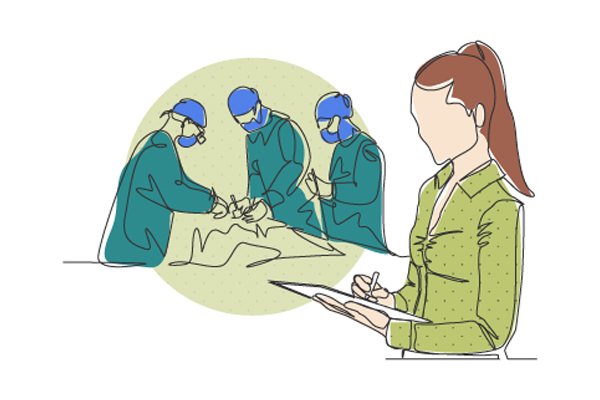How to Circumvent Costly Design Blunders by Bringing HFE Forward in the Device Design and Development Process.
Incorporating Human Factors Engineering (HFE) throughout the device design and development process improves user satisfaction, safety, and effectiveness. However, HFE is often an afterthought or a nice-to-have rather than a critical part of the device design process. For organizations, this can result in substantial unaccounted-for costs that are greatly exacerbated when HFE is not included early enough in the device development process.
In this blog post, we will explore the consequences of retroactively incorporating Human Factors Engineering (HFE) and the benefits of prioritizing HFE from the outset of the design process. Additionally, we will examine why HFE is often overlooked and offer practical suggestions and advice to help you effectively integrate HFE into the device design process and avoid the perils of not doing so.
“Interfaces developed in collaboration with human factors experts had fewer design errors after a single iteration compared to the same interfaces developed by programmers after three to five iterations [1].”
Why don’t companies include Human Factors (HF) early enough in the device design and development process or frequently not at all?
While incorporating Human Factors into your regulatory strategy may not be required for every industry or every product type, it has become standard practice in many sectors. In the pharmaceutical, healthcare, and medical device industries in the United States, the FDA (Food and Drug Administration) requires the application of an appropriately scaled Human Factors and Usability Engineering Process. However, despite the mandated need for HFE and the growing understanding of its importance, organizations still often neglect it or wait until it’s too late and pay a much steeper price in both time and money as a result, and having to re-perform and/or resubmit their usability files. Estimates show that only 10% of first-time Human Factors submissions receive FDA approval. So why do medical device manufacturers frequently choose to skip Human Factors Engineering?
1) Limited project budget
Money is often tight on medical device design and development programs, with Human Factors Engineering seen as an optional activity and cut it from the budget. While program leadership generally believes they don’t have the budget, the real problem is that they haven’t prioritized the items in their budget appropriately – not placing HF as a critical path activity for regulatory and commercial success.
“I have conducted a formative Human Factors study on my own dime because I knew the product needed to be evaluated externally with the people who would actually be using the product before launch.” — Leah Swanson, Director of Human Factors at THRIVE.
The common perception is that HF studies are expensive, costing hundreds of thousands of dollars, and there is some truth to that. As with other systems engineering functions that need to procure material or capital equipment for their work on a project that costs hundreds of thousands of dollars, HF also needs resources to conduct its work to satisfy user needs and regulatory requirements. For example, companies may need to rent out usability testing facilities like THRIVE Labs to complete formative and summative validation studies. And while renting a facility can become expensive, doing so in a prime location enables HF specialists to reach the representative user populations required to evaluate devices and ease the logistical challenges of user participation. Another significant cost of fielding a study is hiring a recruiter to identify and schedule participants, which requires access to specialized participant databases, so usability testing participants can be onboarded efficiently. Recruiting otherwise would typically demand a full-time employee to be onboarded to develop a database of the targeted user populations needed to support these studies. Generating such databases would take months of cold calling. On top of that, studies may need to be double-blinded, thus inhibiting direct recruitment efforts.
Let’s examine the cost of conducting HF evaluations in the grand scheme of things. Let’s say a medical device manufacturer doesn’t do HF evaluations, thereby “saving” the project $100,000—for what it’s worth I believe that if an organization is concerned about saving $100,000, there are better ways to achieve this, for example reducing the amount of material used to manufacture a product. The device design and development team then prepares its regulatory submission. The FDA responds that the required Human Factors activities are conducted inappropriately or even not at all, requiring the manufacturer to do additional analyses or further usability testing, delaying product approval and market launch. An unsuccessful FDA submission is not only frustrating but also exceedingly expensive. During this time, you cannot sell your product, potentially resulting in investors losing confidence and stock prices dropping. All because spending $100,000 on HF evaluations was not deemed critical enough to be funded appropriately. More importantly, customers aren’t taking delivery of their devices as promised to administer the necessary care to patients — a life-changing or even life-saving device is now unavailable to them.
2) Delayed timelines
Human Factors Engineering takes time, like any other research and development activity. But, performing HFE inadequately or not at all equates to a far more significant impact on time and budget. A summative HF validation study must almost always be submitted to the FDA for market approval. For example, lets imagine someone other than a trained HF professional conducts a summative study. In this case, they will likely plan for and execute it incorrectly, misanalyze the data, and provide insufficient information to the FDA. The FDA will respond that HF activities have not been adequately performed and require the manufacturer to conduct them again, appropriately, which delays the new device launch.
3) Human Factors inexperience
Human Factors Engineering can be overwhelming at first, which causes many companies to shy away from engaging the discipline. Recognizing that it is needed — even if the initial steps are confusing — is the perfect place to start. There is a community of HF professionals who are experts at applying it to the design of medical devices. THRIVE is a part of that community. If you want to enhance your understanding of what HF is and how to implement it on your next project, THRIVE can help you achieve first-time FDA approval without delaying timelines and achieving your desired market success.
4) Underestimating the required expertise and using someone other than a trained HFE professional
A common error is thinking that HF means solely performing a summative study to satisfy regulatory requirements. As a result, manufacturers task their engineers or clinicians to do this. However, to be compliant with the international standard, ANSI/AAMI/IEC 62366, the Human Factors/Usability Engineering Process requires that “usability engineering activities for a medical device shall be planned, carried out, and documented by personnel competent based on appropriate education, training, skills, or experience.” Non-HF practitioners are not technically trained in evaluating usability, human behavior, and human performance while interacting with a medical device or system. Nor how to ask the right questions that uncover use-related risk, find usability issues, collect appropriate data, or analyze that data.
5) Treating Human Factors Engineering as a check in a box
Companies occasionally feel forced to do a summative HF study because the FDA mandates them to receive approval to market the product. This step is viewed as the last piece of the puzzle before submission. Not only would I vehemently advise against this approach, but it also completely misses the point of why the FDA mandates it. Some manufacturers fail to realize the benefits of HF as a practice. For those who don’t know much about HF, it’s an enormous field of study and has been embedded within the aviation community for decades. In addition to designing and evaluating the displays and technologies inside the cockpit, HF studies other aspects of the system, such as crew resource management, pilot training, cultural norms, and corporate airline culture and safety informatics, and evaluates how they impact pilot behavior and performance. HF considers human beings’ cognitive and physical abilities and limitations and uses this information to design products that leverage those abilities, making them usable by populations with limitations. That can’t be accomplished by including HF late in a project merely to conduct a summative study—HF should not be looked at as a validation activity but rather as an iterative design and evaluative activity. Another dire miscalculation is when manufacturers say, “my device is not a class II or III device; therefore, the FDA doesn’t require HF.” Even in cases where this is true, it’s still a good idea to do HF to ensure your product is usable. If it’s too cumbersome, users won’t use it, and sales will reflect this.
Get ahead of the competition with an integrated HFE strategy
Bringing Human Factors Engineering (HFE) forward in the medical device design process is a must to achieve first-time FDA approval. Yet, too often, companies include HFE too late into the timeline, or, worse yet, they don’t consider it at all. Companies that take the leap to include HF early and in an integrated way maximize the potential for success. The consequences of not including HFE can be costly. Corporate decision-makers need to recognize this and the importance of using HFE early in the development process and throughout the organization, supporting its active inclusion in every step of device design.
At THRIVE, we are deeply committed to enriching lives through better device design. We are passionate about the correct application of Human Factors Engineering as a critical activity in making this happen. That’s why we provide cutting-edge education, foster deep collaboration between all stakeholders in the design and development process, and demonstrate the total value of incorporating Human Factors Engineering in medical device design and development from the beginning.
Contact THRIVE today for a free consultation on your Human Factors Engineering needs. With years of experience, our Human Factors experts can help you develop a human-centered design approach that is repeatable and meets regulatory requirements to keep your business thriving today and long into the future.
______________________________________________________________________________
1. Sandia National Laboratories is a multi-mission laboratory managed and operated by National Technology and Engineering Solutions of Sandia, LLC, a wholly-owned subsidiary of Honeywell International, Inc., for the U.S. Department of Energy’s National Nuclear Security Administration under contract DE-NA-0003525.
______________________________________________________________________________
ABOUT THRIVE
THRIVE’s Human Factors professionals have decades of experience applying Human Factors to products ranging from medical devices used by specialized healthcare professionals in clinical environments to combination products used by laypeople in the home.
If it’s your first time applying Human Factors and you need a comprehensive end-to-end Human Factors program, we’ll scope out the program and conduct the activities on your behalf, leaving you time and resources to focus elsewhere. If you’re a resource constrained HFE professional, we’ll step in, providing the teamwork, collaboration, and support to help you meet your goals. Or, if you just want a final sanity check to ensure you’ve met the latest and greatest expectations, we’ll do that too.
Contact us today at 404.228.7342 or email [email protected] to get the conversation started.
Atlanta | Chicago | Pittsburgh











